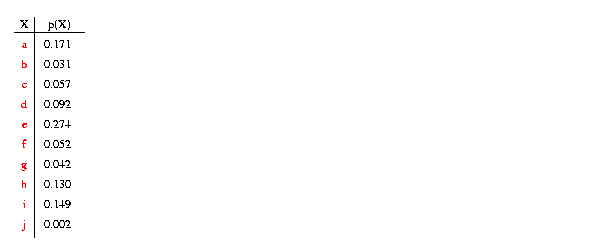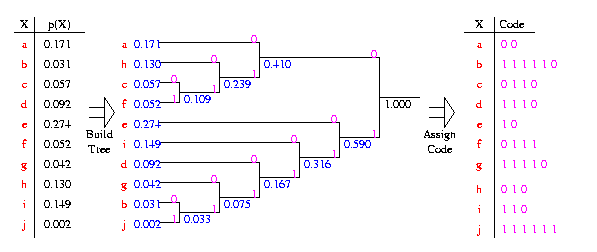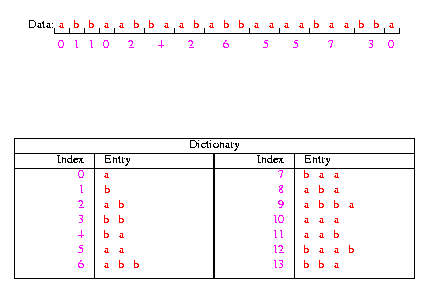Lossless Data Compression
Contents
-
Introduction
-
Huffman Coding
-
Lempel-Ziv Coding
-
Notes
-
References
I. Introduction
The main objective of this page is to introduce two important lossless
compression algorithms:
Huffman Coding and
Lempel-Ziv Coding.
A Huffman encoder takes a block of input characters with
fixed length and produces a block of output bits of
variable length. It is a fixed-to-variable length
code. Lempel-Ziv, on the other hand, is a variable-to-fixed length
code. The design of the Huffman code is optimal (for a fixed
blocklength) assuming that the source statistics are known a priori.
The Lempel-Ziv code is not designed for any particular source but
for a large class of sources. Surprisingly, for any fixed
stationary and ergodic source, the Lempel-Ziv algorithm performs
just as well as if it was designed for that source.
Mainly for this reason, the Lempel-Ziv code is the most widely
used technique for lossless file compression.
II. Huffman Coding
The basic idea in Huffman coding is to assign short codewords to
those input blocks with high probabilities and long codewords to
those with low probabilities.
This concept is similar to that of the
Morse code.
A Huffman code is designed by merging together the two least probable
characters, and repeating this process until there is only one character
remaining. A code tree is thus generated and the Huffman code is obtained from
the labeling of the code tree. An example of how this is done is shown below.
 The final static code tree is given below:
The final static code tree is given below:

- It does not matter how the characters are arranged. I have arranged it
above so that the final code tree looks nice and neat.
- It does not matter how the final code tree are labeled (with 0s and 1s).
I chose to label the upper branches with 0s and the lower branches with 1s.
- There may be cases where there is a tie for the two least
probable characters. In such cases, any tie-breaking procedure is
acceptable.
- Huffman codes are not unique.
- Huffman codes are optimal in the sense that no other lossless
fixed-to-variable length code has a lower average rate.
- The rate of the above code is 2.94 bits/character.
- The entropy lower bound is 2.88 bits/character.
III. Lempel-Ziv Coding
The Lempel-Ziv algorithm
is a variable-to-fixed length code. Basically, there are two versions
of the algorithm presented in the literature: the theoretical
version and the practical version. Theoretically, both versions
perform essentially the same. However, the proof of the asymptotic
optimality of the theoretical version is easier. In practice,
the practical version is easier to implement and is slightly more
efficient. We explain the practical version of the algorithm
as explained in the
book by Gersho and Gray
and in the paper by Welch.
The basic idea is to parse the input sequence into non-overlapping
blocks of different lengths while constructing a dictionary of
blocks seen thus far.
Encoding Algorithm
- Initialize the dictionary to contain all blocks of length one
(D={a,b}).
- Search for the longest block W which has appeared
in the dictionary.
- Encode W by its index in the dictionary.
- Add W followed by the first symbol of the next block to
the dictionary.
- Go to Step 2.
The following example illustrates how the encoding is performed.

Click here to see the animation
(it takes about 2 minutes to loop through the animation)
- Theoretically, the size of the dictionary can grow infinitely large.
- In practice, the dictionary size is limited. Once the limit is reached,
no more entries are added. Welch had recommended a dictionary of size 4096.
This corresponds to 12 bits per index.
- The length of the index may vary. For example, in the n-th block,
the current dictionary size is n+1 (assuming that the limit
has not been reached). Therefore, we can encode the index of block n
using [log2(n+1)] bits (rounded up to the nearest integer).
For example, the first index can be represented by 1 bit, the 2nd and 3rd
by 2 bits each, the 4th, 5th, 6th, and 7th by 3 bits each, and so on.
This is the variable-to-variable length version of the Lempel-Ziv algorithm.
- For a maximum dictionary size of 2m, variable-length
encoding of the indices saves exactly 2m-1 bits
compared to fixed-length encoding.
- The above example, as most other illustrative examples in
the literature, does not result in real compression. Actually, more
bits are used to represent the indices than the original data. This is
because the length of the input data in the example is too short.
- In practice, the Lempel-Ziv algorithm works well (lead to actual
compression) only when the input data is sufficiently large and there
are sufficient redundancy in the data.
- Decompression works in the reverse fashion. The decoder knows that the
last symbol of the most recent dictionary entry is
the first symbol of the next parse block. This knowledge is used
to resolve possible conflict in the decoder.
- Many popular programs (e.g. Unix compress and uncompress, gzip and
gunzip, and Windows WinZip) are based on the Lempel-Ziv algorithm.
- The name ``Ziv-Lempel'' is more appropriate than ``Lempel-Ziv''
(see
Gersho and Gray
and the name ordering in References 3 and 4 below).
IV. Notes
- The following table compares an adaptive version of the Huffman
code (implemented in the Unix ``compact'' program) and an implementation
of the Lempel-Ziv algorithm (Unix ``compress'' program).
|
Adaptive Huffman |
Lempel-Ziv |
| LaTeX file |
66% |
44% |
| Speech file |
65% |
64% |
| Image file |
94% |
88% |
| Size of compressed file as percentage of the original file |
- The large text file described in the
Statistical Distributions of English Text
(containing the seven classic books with a 27-letter English alphabet)
has a compression ratio of
36.3% (original size=5086936 bytes, compressed size=1846919,
using the Linux ``gzip'' program).
This corresponds to a rate of 2.9 bits/character --- compared with
the entropy rate of 2.3 bits/character predicted by Shannon.
This loss of optimality is most likely due to the finite dictionary
size.
V. References
- A. Gersho and R. M. Gray,
Vector Quantization and Signal Compression.
- D. A. Huffman, ``A Method for the Construction of Minimum Redundancy
Codes,'' Proceedings of the IRE, Vol. 40, pp. 1098--1101, 1952.
- J. Ziv and A. Lempel, ``A Universal Algorithm for Sequential Data
Compression,'' IEEE Transactions on Information Theory, Vol. 23,
pp. 337--342, 1977.
- J. Ziv and A. Lempel, ``Compression of Individual Sequences Via
Variable-Rate Coding,'' IEEE Transactions on Information Theory, Vol. 24,
pp. 530--536, 1978.
- T. A. Welch, ``A Technique for High-Performance Data Compression,''
Computer, pp. 8--18, 1984.
Nam Phamdo
Department of Electrical and Computer Engineering
State University of New York
Stony Brook, NY 11794-2350
phamdo@ieee.org
|




